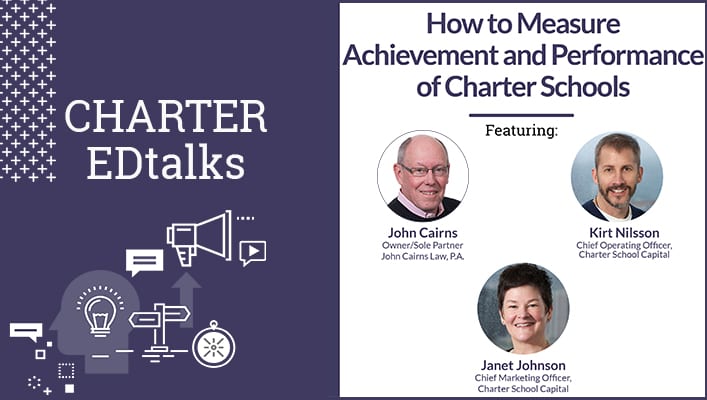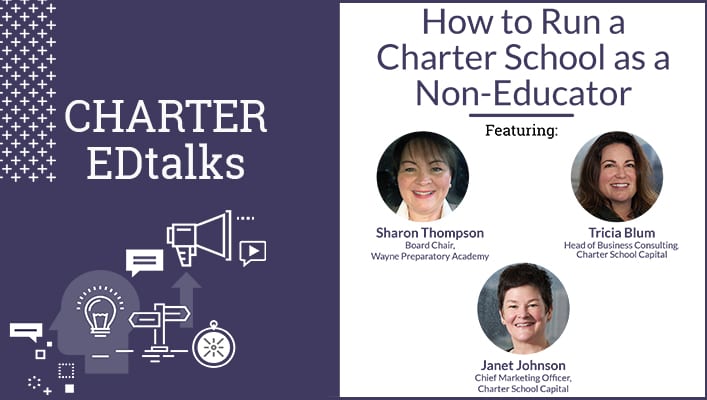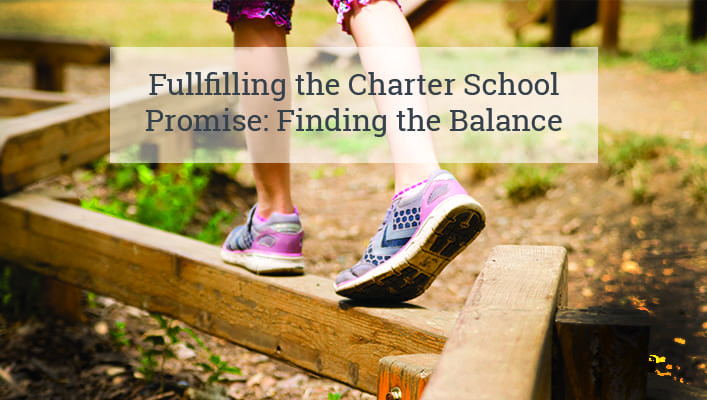 CHARTER EDtalk: How to Measure Charter School Performance and Achievement
CHARTER EDtalk: How to Measure Charter School Performance and Achievement
In this CHARTER EDtalk, Charter School Capital’s Chief Marketing Officer, Janet Johnson, and Chief Operating Officer, Kirt Nilsson, were privileged to sit down with the “father of the charter school movement”, John Cairns. John shares his perspective on how to best measure charter school achievement and performance. He also provides some thoughts on what steps he believes should be taken if a school is found to be underperforming. At the heart of the conversation is the vital nature of accountability and engagement between the school Board, the executive director, and the teaching staff. Watch the video or read the transcript below for the full story.
Janet Johnson (JJ): Good morning. I’m Janet Johnson with Charter School Capital and we’re here with John Cairns, who is one of the founders of the first idea of charter schools and the first law in the nation about charter schools. We’re honored to have you here, John.
John Cairns (JC): Nice to be here.
JJ: Thank you. Along with Kirt Nilsson from Charter School Capital and we’re going to be talking about charter school performance with John.
JC: Good.
On School Choice
Kirt Nilsson (KN): John, we’re doing a campaign at Charter School Capital called, surprisingly, We Love Charter Schools.
JC: Good campaign.
KN: Definitely a good campaign. I’m sure one that you can align with. So, can you tell us in a couple sentences why you love charter schools.
JC: Well, I got interested in the charter school reform movement in 1969 when I was elected into the city council in Minneapolis. And we had a school district within a school district, meaning we had no teacher’s contract.
We had self-governed Boards, we had teachers on Boards. And EDs [executive directors] we selected. We had six elementary schools and so many high schools. That’s how I found public schools,choice was in place. In our neighborhood, where I was a city councilman, parents could choose where you go to school.
I didn’t have any real responsibility. Nobody knew who their school board members were, so they called me all the time to get involved. And I got right in the middle of this. I had no choice, even though two school board members lived on my block. Nobody knew who they were.
So, that got me into the whole choice side and the idea that schools were going to be based on the kids learning. I thought that’s how a traditional system worked, you would think. So that got me started. So, that’s almost 50 years I’ve been on the education reform side of things.
On Measuring Student Achievement
KN: That’s great. And so you mentioned how students learn in their schools, within the charter school world, choice is obviously a big component. So is achievement. How do you think about achievement in charter schools and how it should be looked at, measured?
JC: I’ve been concerned about this since we opened the first school. I think the movement towards tests tells us something about the child’s performance, and it’s a measure. You can at least see the change in the test scores, that’s a measurement.
There are other measures of growth which are not specifically tests. So I start from a standpoint of wanting to see the growth curve through the kids. And because charter schools can be more focused on the kids one-on-one and they spread their money across the classroom with as little administration as possible, there’s usually two adults in every classroom, and they can do some remediation right in that room.
And the other kids are pretty much self-learners and they get started on a project. In fact, I’ve seen several schools where they actually have tables of eight and they started on a topic and the teacher leads the discussion gets them going, and then she’ll pull out one or two of the kids that she knows needs some help. And meanwhile, a senior learner at the table will run the program. So the kids are actually teaching the kids.
KN: That’s amazing.
JC: I saw that even in first grade, some of them.
KN: Leaders of the future.
JC: You bet.
Addressing Underperforming Schools
KN: So, choice is a very powerful thing within the charter school world because parents can choose schools based on what they perceive to be the benefits in achievement. But as we know, sometimes schools aren’t performing the way that they probably should.
What are some routes that you see how that can be addressed? So, what should be done with schools that aren’t performing to the level that probably they should be?
JC: The first place I’d start is with the Board and the ED. They have to admit, and it’s a hard admission to make. So the first step I’d take is I want the Board or the ED to recognize they’ve got a problem. And sometimes the board is very weak and they rely on the ED doing everything.
The Board’s have to understand. Too often that’s not the case. So I’d do a lot board governance to try to get the boards to understand they need to know as much about the school and ask, are the kids learning? Not necessarily all they all advanced, but are they learning?
I try to get every charter school to have their own agenda, have at least a 15-minute discussion about how are the kids learning in this area or in that area. What areas are working best? And then inside the faculty, at the beginning they have to have some sort of way of understanding that they can’t let one teacher have a bad experience and a bad classroom, because it will drag people down.
It’s compounded a bit because charter schools typically get fairly young teachers. In most States, teachers would be a bit reluctant to walk away from a tenured job. Even though in Minnesota they keep their spots. So if a five-year teacher comes to a charter school and works five years, they still have five years of tenure. They don’t gain any tenure, but they still have the five.
So I’d go to the board, the ED and I’d try to get the faculty to have some leadership to say, “This isn’t working very well. What should we do?” Out of that ought to come –with the authorizer – some sort of transformation process. It should. And it could be new leadership, it could be new ED, it could be better organizing or training the faculty. But the Board’s got to be in charge of that, and if the board isn’t willing to take charge of that then it’s simply going to stay there and get worse.
KN: It starts with leadership, right?
JC: You bet.
Assessing a School’s Improvement
KN: So then with that leadership, assuming it plays the way it ought to be, how do you know when a school that was under-performing starts to perform? What are some of the things and signs that you see of, “Oh yeah. They’re heading in the right direction.”
JC: Well, you certainly will see an improvement in internal testing on subject matter, and they do some standardized tests that aren’t required. Many schools will do something every month of their own creation that they think is a measure of kids learning. And that goes down just like the standard scores go down, so they’ll first see a turn in the internal testing.
You’ll then start to see some sort of project-based learning. So the kids not only have a test, they have a product of something they’ve done and it’s going to be out of enjoyment. So the kids identify with this, in particular, when you go to say, fourth grade. It’s a little harder in K-3. But they have an outcome. It’s visible, touchable and it’s something that happens every month, not just once a year.
And the third thing I’d look to see is, the enthusiasm from the teachers because if they’re in a school that’s not doing well they’re not going to feel very good about themselves. But when it starts to turn, they all of a sudden say, “Oh! We can do this. This will really work.” You see a completely different attitude. And then the board should be acting the same way. So you start to see a slow turn-up.
And some schools can’t pull it off, and so we have closures. In Minnesota, we have 165 schools open now but in the 20 or 30 years, we’ve done this we’ve probably authorized 260. And some of those schools today are new. So we’ve probably closed somewhere between, around 80 schools. Over the years.
Lack of money, usually it’s lack of enrollment. We’ve had no fiscal management coaches for about 10 years, because we’ve learned much about how to make that work. We had a few rip-offs back in the first round of schools, so we watch carefully about the board really being engaged. That’s a good sign.
On Working with Charter School Capital
KN: We all are interested in the success of charter schools, and those that are performing are so fun to watch. Those that are having challenges are fun to work with and try and get them to move forward. So we’re all headed in that direction, Charter School Capital included. So we’ve worked together for a bunch of years, what’s your experience been like in working with Charter School Capital?
JC: I first met Stuart and one of the partners who’s left, I think in 2009 or 2010. Minnesota schools had a budget shortfall, so we were trying to fill the gaps from the shortfall. And after the first two days of being with them, as they were leaving, I said, “Two things. One is, the biggest problem the charter school industry has, is lack of capital to grow, and lack of capital to manage the schools. And the second thing I said was, if I was 20 years younger I would stop my law practice and join Charter School Capital.”
JJ: That’s great.
JC: So, it’s been a great experience. I mean, I think in some ways I may be a little underused, in the sense that one of the things I’ve been able to do is, for anybody who gets confused or doesn’t understand the charter school concept or charter school practice, I’ve had a number of calls. And I probably should make it more clear to people that, that’s part of my mission—to take the call anytime about somebody who can’t figure out.
JJ: So you’ve heard it here, folks. He’s ready to take the call.
JC: I’m ready to take the call. From anybody inside Charter School Capital or outside.
JJ: That’s great. Thank you so much, John, for joining us today. We really appreciate your work on our behalf, too.
JC: I think Charter School Capital is just a fabulous organization.
KN: Thank you, John.
 Since the company’s inception in 2007, Charter School Capital has been committed to the success of charter schools. We provide growth capital and facilities financing to charter schools nationwide. Our depth of experience working with charter school leaders and our knowledge of how to address charter school financial and operational needs have allowed us to provide over $1.8 billion in support of 600 charter schools that have educated over 1,000,000 students across the country. For more information on how we can support your charter school, contact us. We’d love to work with you!
Since the company’s inception in 2007, Charter School Capital has been committed to the success of charter schools. We provide growth capital and facilities financing to charter schools nationwide. Our depth of experience working with charter school leaders and our knowledge of how to address charter school financial and operational needs have allowed us to provide over $1.8 billion in support of 600 charter schools that have educated over 1,000,000 students across the country. For more information on how we can support your charter school, contact us. We’d love to work with you!


